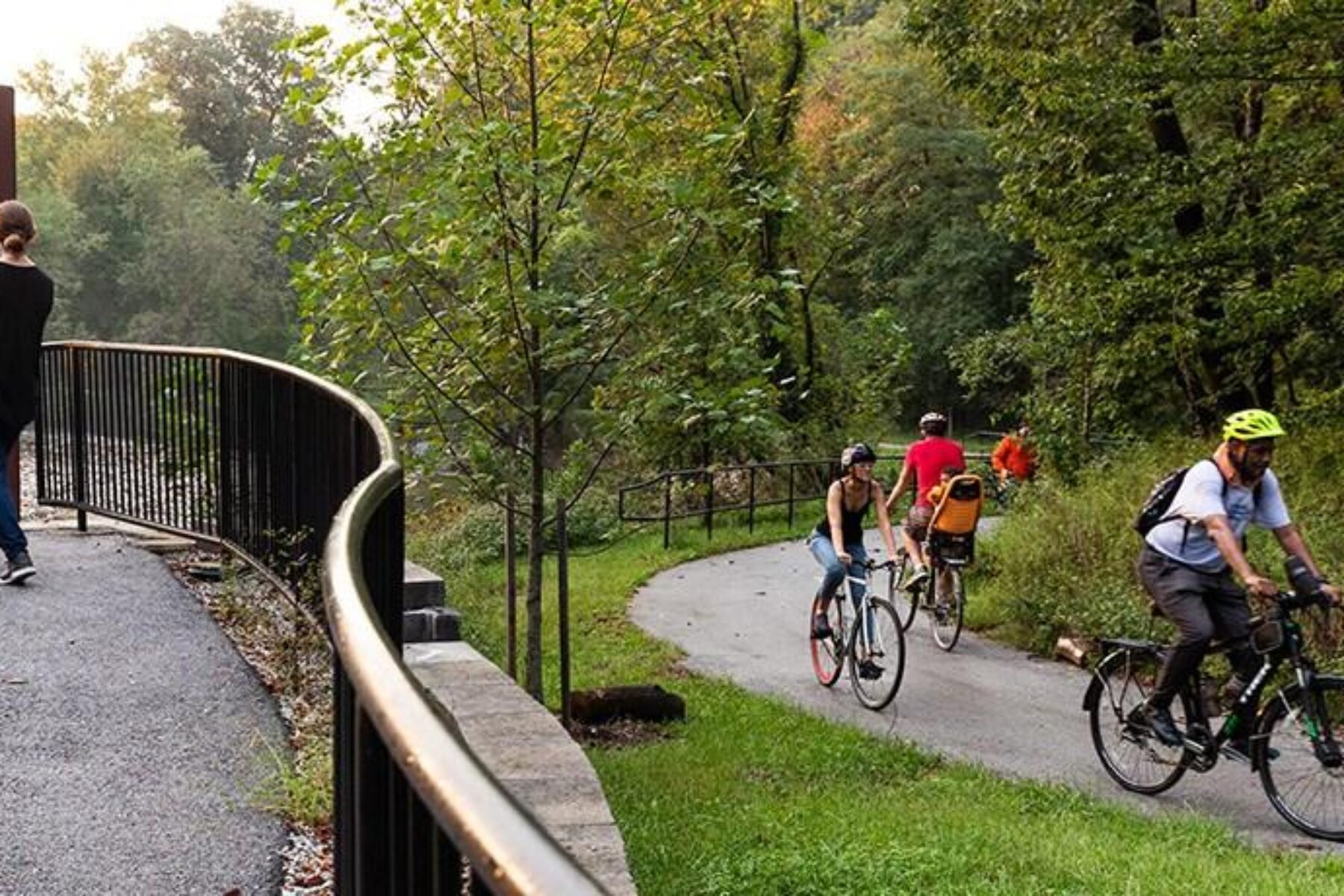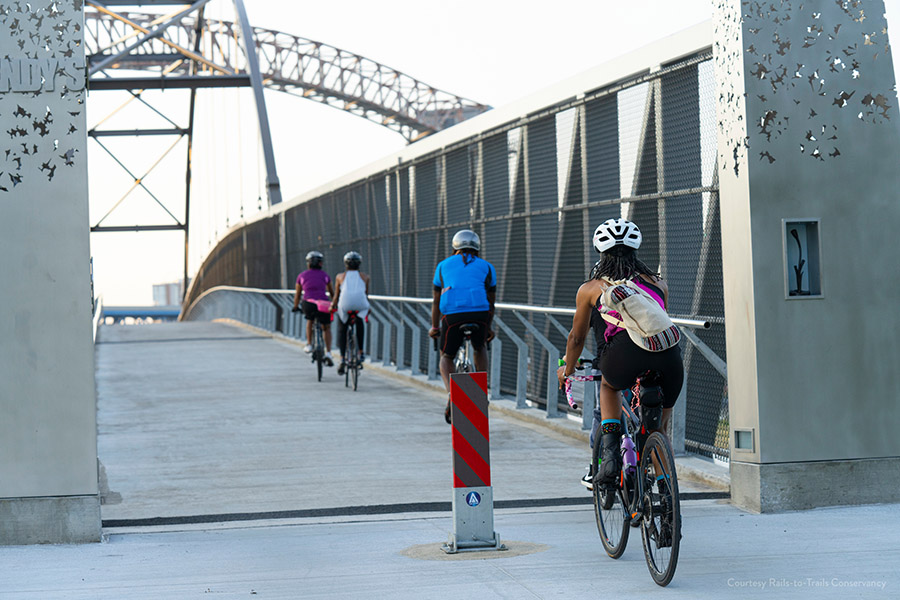The Critical Role of Active Transportation in the Federal Carbon Reduction Program

The Bipartisan Infrastructure Law (BIL) created many new eligible funding sources for active transportation focused on safety, equity and climate. One promising new climate-focused program is the Carbon Reduction Program (CRP), which provides $6.4 billion in formula funds over five years, and requires 65% of funds to be suballocated based on population.
CRP mandates that states develop carbon reduction strategies designed to reduce transportation emissions from on-road highway sources, and—as part of this process—that states and regions identify specific projects and strategies that will help them reach the goals set in their plan.

With eligibility for trails, walking and biking projects, CRP program funding will also help in achieving mode shift, a critical strategy for addressing the climate impacts of the transportation sector. Of note: All projects that are eligible under the Transportation Alternatives (TA) program—including construction, planning and design—are eligible for CRP funding. This demonstrates a recognition by Congress of the transformative impact that active transportation can play in carbon reduction and mode shift.
You can learn more about CRP eligibilities on RTC’s funding page.
To maximize the impact of CRP, it is imperative that states include walking and bicycling, which are zero-carbon forms of transportation, in both their CRP goals and strategies. By including trail connections and other active transportation facilities as key components, states can effectively lower their emissions and reap the many other benefits of providing low-cost and healthy mobility options for residents.

Ahead of the CRP strategy deadline this fall (November of 2023), RTC spoke with departments of transportation (DOTs) and metropolitan planning organizations (MPOs) across the country to better understand the innovative and exciting ways that states and regions are including trail and active transportation networks as key components in their plans.
Many of these ideas—summarized here—are easy to replicate, and we encourage you to work with your DOT or MPO to try to implement these concepts and advocate for using active transportation to reduce transportation emissions.
Consider putting CRP funds directly into Transportation Alternatives (TA):
- Some states have chosen to transfer CRP funds directly into TA programs, thus increasing available funds for projects. As mentioned above, TA-eligible projects are also eligible for CRP funding. TA is the largest dedicated funding source for trails, walking and biking, and a vast majority of TA funds now flow to those eligibilities. Transferring funds to TA is administratively convenient and ensures CRP investment in these important projects. Transferring funding in this way also creates more opportunities for active transportation networks in creating mode shift and reducing carbon emissions.
When choosing projects to fund, focus on connectivity and safety:
- When administering funding, states and MPOs often assess which projects have the biggest impact in carbon reduction. To ensure a significant impact, RTC recommends that decision-makers prioritize active transportation networks and connectivity to everyday destinations, such as public transit, schools or business hubs. We also recommend prioritizing traffic-separated infrastructure to ensure walking and biking are safe and popular for all ages and abilities.
- Some states have chosen to score projects on a points system and allot additional points for active transportation projects that are traffic-separated and/or are located close to public transportation. This adjustment is an easy change that would result in better-connected and safer projects.
- By emphasizing safety and connectivity in projects, decision-makers can feel confident that more users will choose biking and walking, thus lowering emissions significantly and contributing to modeshift.
Focus on community engagement and clear application criteria:
- There were multiple states and MPOs that underwent significant community engagement processes to develop their CRP strategies. By engaging in robust community engagement, you can ensure that plans are supported by the community and that various stakeholders understand the importance and benefits of trails and active transportation. You can also help increase your supporter base and stimulate advocacy for further CRP investment in trails, walking and biking.
- It is imperative to create a transparent and clear application process to ensure all eligible applicants understand when and how to apply, and how different criteria will be weighed and scored. As mentioned above, we recommend the application criteria include safety and connectivity, as well as an estimated impact on carbon reduction, so applicants can focus on these prioritized elements in projects and applications. Being transparent about the process and how to succeed will help increase the number of applications and make projects more impactful.
Consider running one larger funding cycle to support larger projects:
- Rather than using funds each year, MPOs and states can consider pooling funding for one or two application cycles to fund larger projects. By saving up annual allotments of CRP funds and combining them into larger cycles, CRP can support the development and completion of sizeable and/or more expensive and harder to fund projects that could have a major impact on both carbon reduction outcomes and connectivity.
Include trail and active transportation networks as key components of CRP strategies:
- As state DOTs create their carbon reduction plans, it’s imperative that active transportation is a core part of their CRP strategies. (We have seen multiple states do this as part of their November submissions.)
- By focusing on trails, walking and biking in strategies, states are showing that they recognize active transportation as critical to mode shift and the establishment of sustainable transportation in America.
Trails, walking and biking are cost-effective solutions to substantially reduce emissions and create safe and sustainable ways for Americans to get to routine destinations. States and MPOs should consider the ideas above to ensure they are investing their CRP funding most strategically.
It is also important that states and MPOs hear from advocates to encourage them to use these ideas to ensure maximum effectiveness of CRP. In addition to contacting your state DOTs and MPOs directly, RTC recommends you seek out and participate in public comment periods for CRP strategies, which are likely occurring this summer.
CRP strategies—which are required by law—are due this November, so engagement over the coming months is critical.
Learn more about CRP.

Donate
Everyone deserves access to safe ways to walk, bike, and be active outdoors.